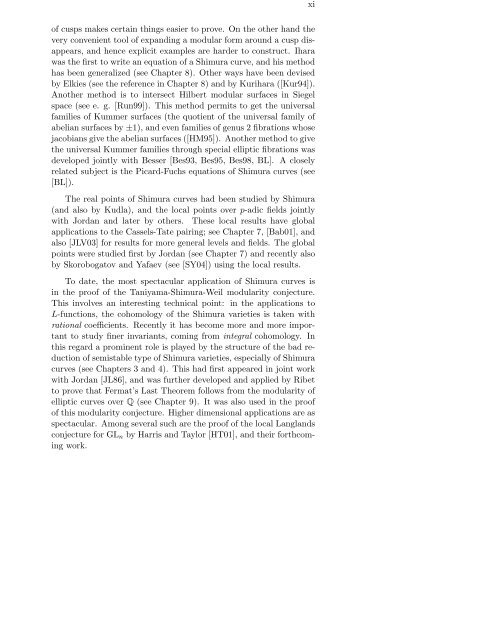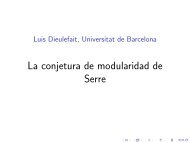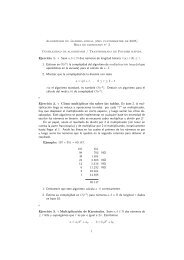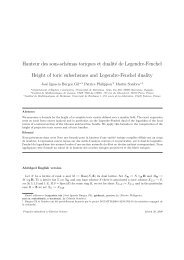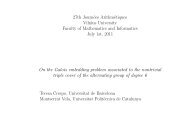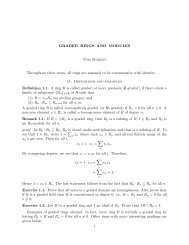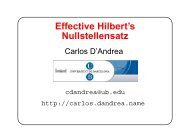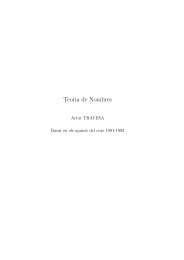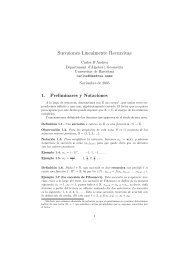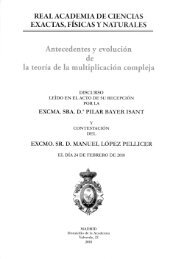CORBES DE SHIMURA I APLICACIONS - Universitat de Barcelona
CORBES DE SHIMURA I APLICACIONS - Universitat de Barcelona
CORBES DE SHIMURA I APLICACIONS - Universitat de Barcelona
You also want an ePaper? Increase the reach of your titles
YUMPU automatically turns print PDFs into web optimized ePapers that Google loves.
of cusps makes certain things easier to prove. On the other hand the<br />
very convenient tool of expanding a modular form around a cusp disappears,<br />
and hence explicit examples are har<strong>de</strong>r to construct. Ihara<br />
was the first to write an equation of a Shimura curve, and his method<br />
has been generalized (see Chapter 8). Other ways have been <strong>de</strong>vised<br />
by Elkies (see the reference in Chapter 8) and by Kurihara ([Kur94]).<br />
Another method is to intersect Hilbert modular surfaces in Siegel<br />
space (see e. g. [Run99]). This method permits to get the universal<br />
families of Kummer surfaces (the quotient of the universal family of<br />
abelian surfaces by ±1), and even families of genus 2 fibrations whose<br />
jacobians give the abelian surfaces ([HM95]). Another method to give<br />
the universal Kummer families through special elliptic fibrations was<br />
<strong>de</strong>veloped jointly with Besser [Bes93, Bes95, Bes98, BL]. A closely<br />
related subject is the Picard-Fuchs equations of Shimura curves (see<br />
[BL]).<br />
The real points of Shimura curves had been studied by Shimura<br />
(and also by Kudla), and the local points over p-adic fields jointly<br />
with Jordan and later by others. These local results have global<br />
applications to the Cassels-Tate pairing; see Chapter 7, [Bab01], and<br />
also [JLV03] for results for more general levels and fields. The global<br />
points were studied first by Jordan (see Chapter 7) and recently also<br />
by Skorobogatov and Yafaev (see [SY04]) using the local results.<br />
To date, the most spectacular application of Shimura curves is<br />
in the proof of the Taniyama-Shimura-Weil modularity conjecture.<br />
This involves an interesting technical point: in the applications to<br />
L-functions, the cohomology of the Shimura varieties is taken with<br />
rational coefficients. Recently it has become more and more important<br />
to study finer invariants, coming from integral cohomology. In<br />
this regard a prominent role is played by the structure of the bad reduction<br />
of semistable type of Shimura varieties, especially of Shimura<br />
curves (see Chapters 3 and 4). This had first appeared in joint work<br />
with Jordan [JL86], and was further <strong>de</strong>veloped and applied by Ribet<br />
to prove that Fermat’s Last Theorem follows from the modularity of<br />
elliptic curves over Q (see Chapter 9). It was also used in the proof<br />
of this modularity conjecture. Higher dimensional applications are as<br />
spectacular. Among several such are the proof of the local Langlands<br />
conjecture for GLn by Harris and Taylor [HT01], and their forthcoming<br />
work.<br />
xi


